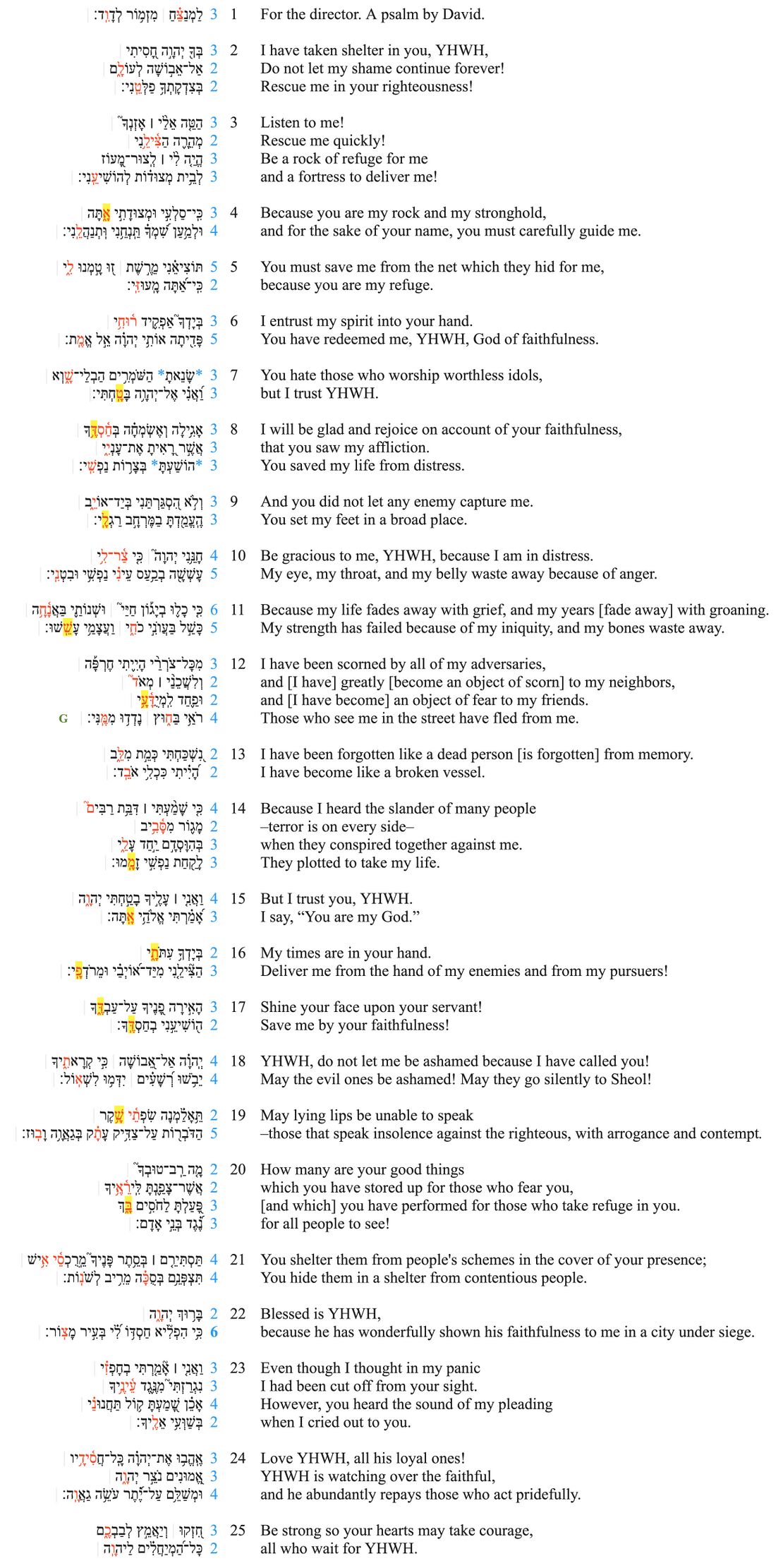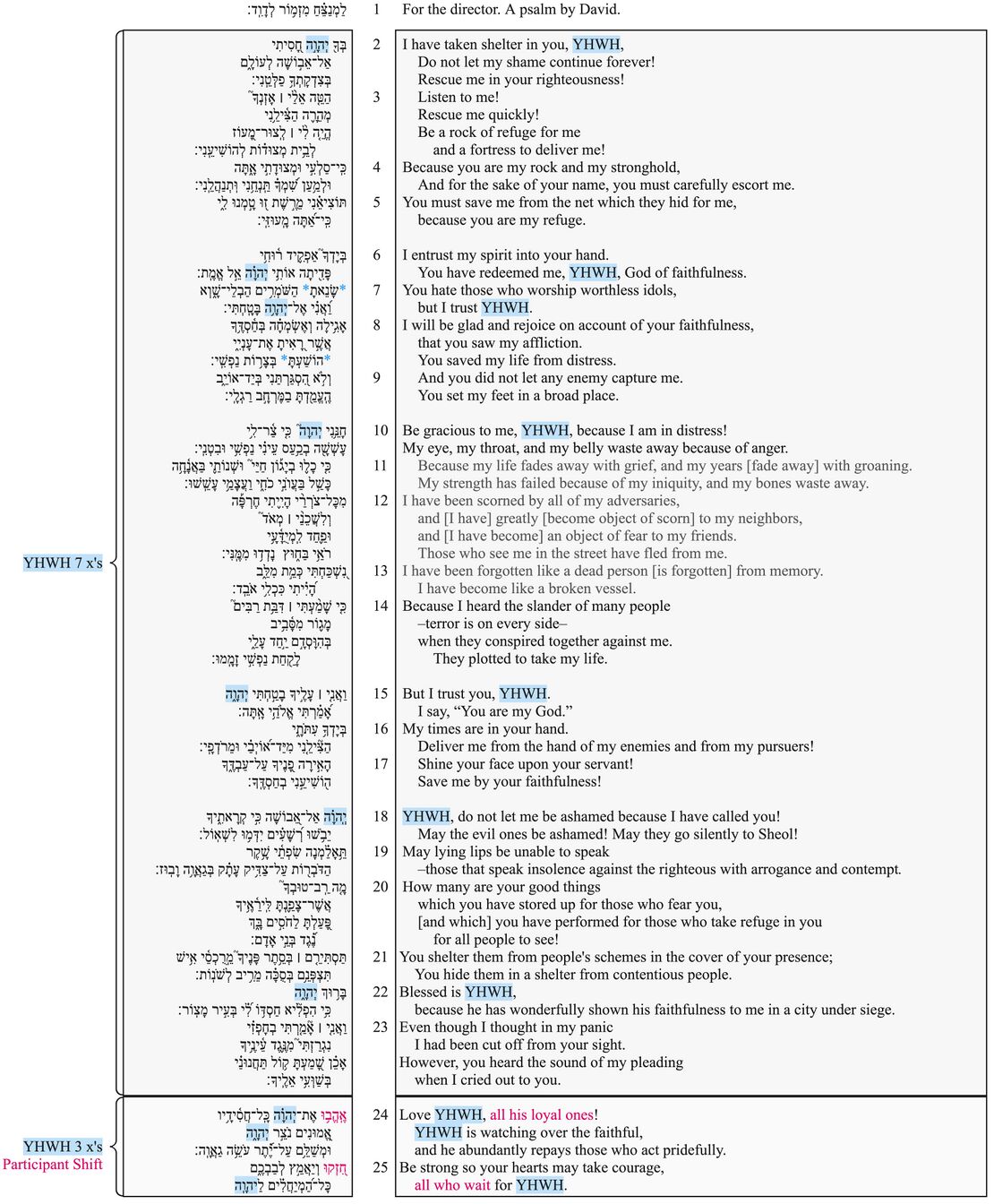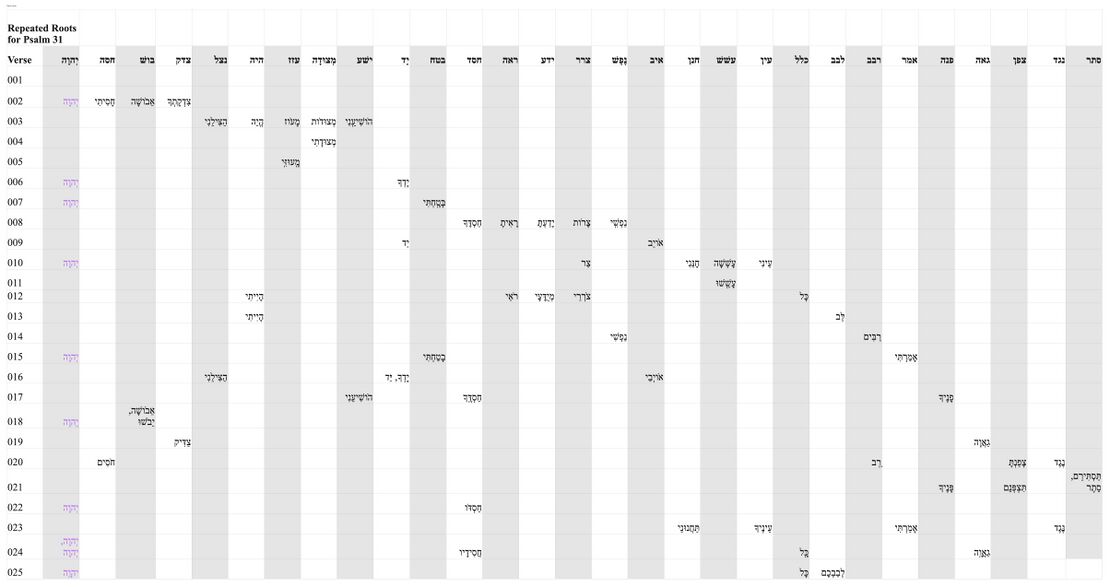Psalm 31 Poetry
About the Poetics Layer
Exploring the Psalms as poetry is crucial for understanding and experiencing the psalms and thus for faithfully translating them into another language. This layer is comprised of two main parts: Poetic Structure and Poetic Features.
Poetic Structure
In poetic structure, we analyse the structure of the psalm beginning at the most basic level of the structure: the line (also known as the “colon” or “hemistich”). Then, based on the perception of patterned similarities (and on the assumption that the whole psalm is structured hierarchically), we argue for the grouping of lines into verses, verses into strophes, strophes into stanzas, etc. Because patterned similarities might be of various kinds (syntactic, semantic, pragmatic, sonic) the analysis of poetic structure draws on all of the previous layers (especially the Discourse layer).
Poetic Features
Bibliography
- Barthélemy, Dominique. 2005. Critique Textuelle de l’Ancien Testament. Vol. Tome 4: Psaumes. Fribourg, Switzerland: Academic Press.
- Basson, A. 2005. “‘You Are My Rock and Fortress’. Refuge Metaphors in Psalm 31. a Perspective from Cognitive Metaphor Theory.” Acta Theologica 25 (2): 1–17.
- Bratcher, Robert G., and William D. Reyburn. 1991. A Handbook on Psalms. UBS Handbook Series. New York: United Bible Societies.
- Briggs, Charles A., and Emilie Briggs. 1906. A Critical and Exegetical Commentary on the Book of Psalms. Vol. 1. ICC. Edinburgh: T & T Clark.
- Brockington, L. H. 1973. The Hebrew Text of the Old Testament: The Readings Adopted by the Translators of the New English Bible.
- Brueggemann, Walter, and W. H. Bellinger. 2014. Psalms. New York: Cambridge University Press.
- Calvin, John. n.d. Commentary on the Book of Psalms. Translated by James Anderson. Grand Rapids: Christian Classics Ethereal Library.
- Cohen, Chaim. 2004. “The Enclitic-Mem in Biblical Hebrew: Its Existence and Initial Discovery.” In Sefer Moshethe Moshe Weinfeld Jubilee Volume: Studies in the Bible and the Ancient Near East, Qumran, and Post-Biblical Judaism, 231–60. Winona Lake, Ind.
- Companioni, Carrera, and Roberto Adrian. 2022. “The Mercati Fragments: A New Edition of Rahlfs 1098,” December.
- Conybeare, F. C. (Frederick Cornwallis). 1905. Selections from the Septuagint: According to the Text of Swete. Boston : Ginn & Company.
- Craigie, Peter C. 1983. Psalms 1–50. WBC 19. Waco, TX: Word.
- Dahood, Mitchell edt trl. 1966. Psalms. Garden City, N.Y., Doubleday.
- DeClaisse-Walford, Nancy L., Rolf A. Jacobson, and Beth LaNeel Tanner. 2014. The Book of Psalms. New International Commentary on the Old Testament. Grand Rapids, MI: Eerdmans.
- Delekat, L. 1964. “Zum Hebräischen Wörterbuch.” Vetus Testamentum 14 (1): 7–66.
- Dion, Paul-Eugène. 1987. “Strophic Boundaries and Rhetorical Structure in Psalm 31.” Église et Théologie 18 (2): 183–92.
- Fokkelman, J.P. 2000. Major Poems of the Hebrew Bible: At the Interface of Prosody and Structural Analysis (Vol 2: 85 Psalms and Job 4–14). Studia Semitica Neerlandica. Van Gorcum.
- Hummel, Horace D. 1957. “Enclitic Mem in Northwest Semitic, Especially Hebrew.” Journal of Biblical Literature 76 (2): 85–104.
- Laberge, Léo. 1985. “A Literary Analysis of Psalm 31.” Église et Théologie 16 (2): 147–68.
- Lugt, Pieter van der. 2006. Cantos and Strophes in Biblical Hebrew Poetry: With Special Reference to the First Book of the Psalter. Vol. 1. 3 vols. Oudtestamentische Studiën 53. Leiden: Brill.
- Mena, Andrea K. 2012. “The Semantic Potential of ’al in Genesis, Psalms, and Chronicles.” Stellenbosch : Stellenbosch University.
- Merwe, C H J van der. 1993. “Old Hebrew Particles and the Interpretation of Old Testament Texts.” Journal for the Study of the Old Testament 18 (60): 27–44.
- Miller, Cynthia L. 2010. “Vocative Syntax in Biblical Hebrew Prose and Poetry: A Preliminary Analysis.” Journal of Semitic Studies 55 (2): 347–64.
- Potgieter, J. Henk. 2012. “‘David’ in Consultation with the Prophets: The Intertextual Relationship of Psalm 31 with the Books of Jonah and Jeremiah.” Old Testament Essays 25 (1): 115–26.
- Roberts, J J M. 1975. “Niskahtî--Millēb, Ps 31:13: Vetus Testamentum.” Vetus Testamentum 25 (4): 797–801.
- Villanueva, Federico G. 2016. Psalms 1-72. Carlisle, England: Langham Global Library.






